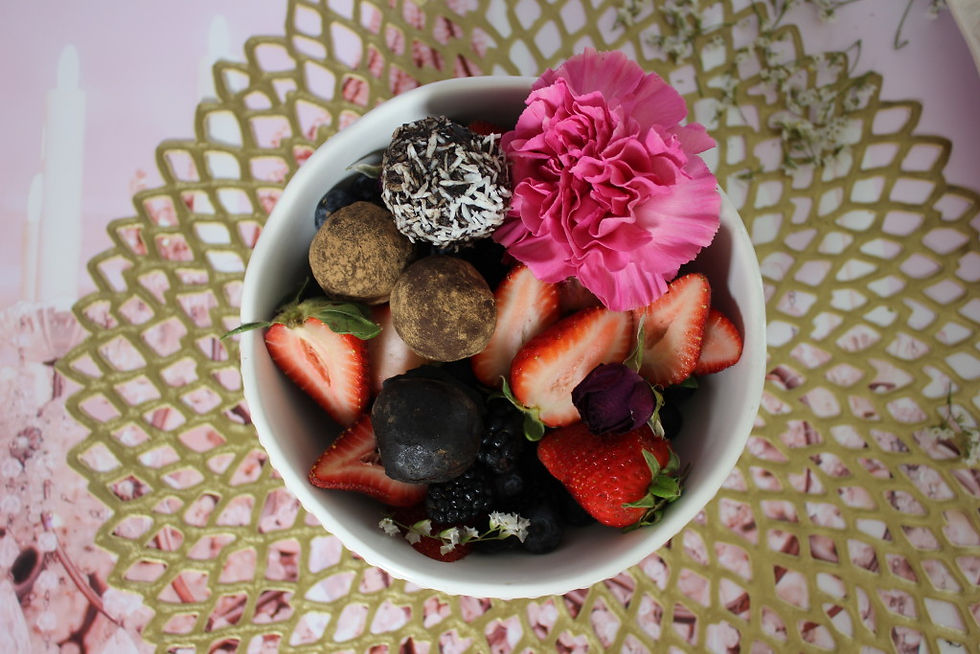Prodigious Antioxidant Power, Minuscule Publicity: Operation Promote Flavonoids Is Officially Under
- Talia

- Mar 3, 2016
- 3 min read

Just when you thought fruits and vegetables couldn’t get any healthier, in walks the latest research on flavonoids and compelling studies indicating that flavonoids are incredible for our health. What are flavonoids?! Why should you care? Well aside from increasing your nutrition IQ at least 5 points once you learn about them (random number, I know, but I also happen to know that this will be the minimum number of points increased- don’t ask how I know, just believe!), it is highly likely that you will be compelled to consume more flavonoid-rich foods, and hence, become even healthier, your risk of later-life diseases plummeting.
I was so intrigued by the power of flavonoids when I read about them long, long ago in college (just kidding, it wasn’t that long ago and I vehemently deny accusations of being an ancient human being by my 7-year-old cousin) that I wrote an entire chapter about them in Love Your Body. Here is a sneak peak regarding what you will find if you open the book to chapter 6 (the brain health chapter!). In fact, you are about to behold a complimentary excerpt of my favorite flavonoid findings from the book.
“Blueberries, cherries, leafy green veggies and soy all have something in common that gives them their brain-boosting power. They’re tiny, microscopic marvels called flavonoids. These gorgeously salubrious chemicals have been shown to enhance memory, learning, and general cognitive function, including reasoning skills, decision making, verbal comprehension, and numerical ability. And that’s just in the short-term. The long-term benefits of consuming flavonoid-rich foods are that they slow down the mental decline seen with aging and they can protect us against brain-related diseases such as Alzheimer’s and Parkinson’s. Can you imagine if Allie from The Notebook never had Alzheimer’s? She and Noah could have had even more blissfully romantic years together.
Flavonoids are plant compounds promiscuous in their affection, and they love all our organs, especially our hearts, arteries, and brains. They do an impressive job of combating free radicals, and in doing so, they boost our immunity to viral and bacterial diseases, stave off cancer, and reduce excess inflammation. They also help regulate blood flow and blood pressure. Flavonoid-rich foods not only protect us from diseases, but they can actually improve aspects of cognition such as verbal comprehension, objective recall, reasoning and decision making, and recognition of numerical patterns.
Isn’t that amazing?
Scientists once thought that flavonoids interact in the brain the same way they do in the body—like antioxidants that protect cells from damage caused by malicious free radicals. However, now scientists realize that the real magic is in how flavonoids interact with proteins that are integral to brain cell structure and function. Researchers have been able to show that flavonoids cross into the brain from our bloodstreams—once in our brains, they alter the chemistry of neurons in a highly positive way. Flavonoids enable the production of enzymes called brain kinases, and many of these kinases are vital to preserving our capacity to learn and memorize. More than 6,000 different flavonoids have now been discovered; they come in different classes with scientific names like flavonols, flavones, and anthocyanins (and other names you don’t need to know). The only thing you need to remember is which foods are richest in these compounds.”
Here are the top 15 flavonoid-rich foods (in no particular order):
All cruciferous veggies (think kale, spinach, bok choy, arugula, Brussels sprouts, broccoli, and mustard greens)
Red bell peppers
Onions (both red and yellow are totally flav-rich)
All berries (every single one!)
Pomegranates
Cocoa (dark chocolate)
Unprocessed soy foods like edamame, tofu, and tempeh
All beans
Oranges and other citrus fruits such as clementines, lemons, and limes
Apples (flavonoids are concentrated in the skin)
Eggplant (again, those flavs are in the skin)
All nuts (walnuts, pecans, pistachios, Brazil nuts, cashews, etc.)
All seeds (sunflower, pumpkin, chia, flax, etc.)
Red grapes (go organic, peeps; conventional grapes tend to drip nasty pesticides)
Green, black, and white teas


Scientific references employed in this article:
1) “Flavonoids: Modulators of Brain Function?” British Journal of Nutrition (E. Supplement 1, 2008): ES60–77. 2) J. P. Spencer, “The Impact of Flavonoids on Memory: Physiological and Molecular Considerations,” Chemical Society Reviews 38 (2009): 1152–61. 3) S. Schaffer, G. P. Eckert, S. Schmitt–Schillig, and W. E. Muller, “Plant Foods and Brain Aging: A Critical Appraisal,” Forum of Nutrition 59 (2006): 86–115. 4) K. A. Youdim, J. P. E. Spencer, H. Schroeter, and C. Rice-Evans, “Dietary Flavonoids as Potential Neuroprotectants,” Biological Chemistry 383 (2002): 503–19. 5) K. A. Youdim et al., “Flavonoids and the Brain: Interactions at the Blood-Brain Barrier and Their Physiological Effects on the Central Nervous System,” Free Radical Biology and Medicine 37, no. 11 (2004): 1683–93. 6) L. Letenneur, A. Le Gouge, C. Proust-Lima, et al., “Flavonoid Intake and Cognitive Decline over a 10-Year Period,” American Journal of Epidemiology 165, no. 12 (2007): 1364–71.
Peace, love, kale and over and out!




Comments